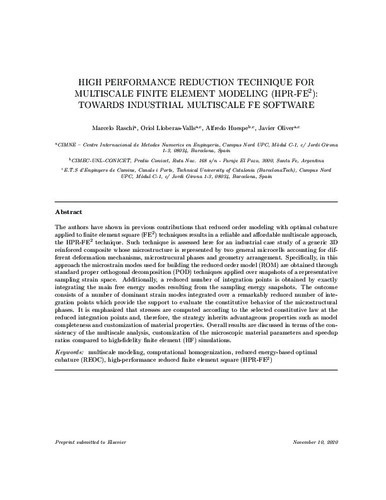Mostra el registre d'ítem simple
High performance reduction technique for multiscale finite element modeling (HPR-FE2): towards industrial multiscale FE software
| dc.contributor.author | Raschi Schaw, Marcelo |
| dc.contributor.author | Lloberas Valls, Oriol |
| dc.contributor.author | Huespe, Alfredo Edmundo |
| dc.contributor.author | Oliver Olivella, Xavier |
| dc.contributor.other | Universitat Politècnica de Catalunya. Departament d'Enginyeria Civil i Ambiental |
| dc.date.accessioned | 2020-12-17T12:21:50Z |
| dc.date.available | 2022-12-15T01:29:56Z |
| dc.date.issued | 2021-03 |
| dc.identifier.citation | Raschi, M. [et al.]. High performance reduction technique for multiscale finite element modeling (HPR-FE2): towards industrial multiscale FE software. "Computer methods in applied mechanics and engineering", Març 2021, vol. 375, p. 113580:1-113580:23. |
| dc.identifier.issn | 0045-7825 |
| dc.identifier.uri | http://hdl.handle.net/2117/334612 |
| dc.description.abstract | The authors have shown in previous contributions that reduced order modeling with optimal cubature applied to finite element square (FE) techniques results in a reliable and affordable multiscale approach, the HPR-FE2 technique. Such technique is assessed here for an industrial case study of a generic 3D reinforced composite whose microstructure is represented by two general microcells accounting for different deformation mechanisms, microstrucural phases and geometry arrangement. Specifically, in this approach the microstrain modes used for building the reduced order model (ROM) are obtained through standard proper orthogonal decomposition (POD) techniques applied over snapshots of a representative sampling strain space. Additionally, a reduced number of integration points is obtained by exactly integrating the main free energy modes resulting from the sampling energy snapshots. The outcome consists of a number of dominant strain modes integrated over a remarkably reduced number of integration points which provide the support to evaluate the constitutive behavior of the microstructural phases. It is emphasized that stresses are computed according to the selected constitutive law at the reduced integration points and, therefore, the strategy inherits advantageous properties such as model completeness and customization of material properties. Overall results are discussed in terms of the consistency of the multiscale analysis, customization of the microscopic material parameters and speedup ratios compared to high-fidelity finite element (HF) simulations. |
| dc.description.sponsorship | The authors acknowledge financial support from the Spanish Ministry of Economy and Competitiveness, through the “Severo Ochoa Programme for Centres of Excellence in R&D, Spain” (CEX2018-000797-S) and the research grant DPI2017-85521-P for the project “Computational design of Acoustic and Mechanical Metamaterials” (METAMAT), Spain. This research has also received funding from the European Research Council (ERC) under the European Union’s Horizon 2020 research and innovation program (Proof of Concept Grant agreement 874481) through the project “Computational design and prototyping of acoustic metamaterials for target ambient noise reduction” (METACOUSTIC). The authors also acknowledge the guidance and assistance with the microcells meshes from Dr. Pedro Camanho and Dr. Fermín Otero from INEGI (Portugal) during the preparation of this manuscript. |
| dc.language.iso | eng |
| dc.rights | © 2019. Elsevier |
| dc.rights | Attribution-NonCommercial-NoDerivatives 4.0 International |
| dc.rights.uri | https://creativecommons.org/licenses/by-nc-nd/4.0/ |
| dc.subject | Àrees temàtiques de la UPC::Matemàtiques i estadística::Anàlisi numèrica::Mètodes en elements finits |
| dc.subject.lcsh | Multiscale modeling |
| dc.subject.other | Multiscale modeling |
| dc.subject.other | Computational homogenization |
| dc.subject.other | Reduced energy-based optimal cubature (REOC) |
| dc.subject.other | High-performance reduced finite element square (HPR-FE2) |
| dc.title | High performance reduction technique for multiscale finite element modeling (HPR-FE2): towards industrial multiscale FE software |
| dc.type | Article |
| dc.subject.lemac | Modelització en etapes múltiples |
| dc.contributor.group | Universitat Politècnica de Catalunya. RMEE - Grup de Resistència de Materials i Estructures en l'Enginyeria |
| dc.identifier.doi | 10.1016/j.cma.2020.113580 |
| dc.description.peerreviewed | Peer Reviewed |
| dc.relation.publisherversion | https://www.sciencedirect.com/science/article/abs/pii/S0045782520307659 |
| dc.rights.access | Open Access |
| local.identifier.drac | 30019115 |
| dc.description.version | Postprint (author's final draft) |
| dc.relation.projectid | info:eu-repo/grantAgreement/AEI/Plan Estatal de Investigación Científica y Técnica y de Innovación 2013-2016/DPI2017-85521-P/ES/DISEÑO COMPUTACIONAL DE METAMATERIALES ACUSTICOS Y MECANICOS/ |
| dc.relation.projectid | info:eu-repo/grantAgreement/EC/H2020/874481/EU/Computational design and prototyping of acoustic metamaterials for tailored insulation of noise/METACOUSTIC |
| local.citation.author | Raschi, M.; Lloberas-Valls, O.; Huespe, A.; Oliver, J. |
| local.citation.publicationName | Computer methods in applied mechanics and engineering |
| local.citation.volume | 375 |
| local.citation.startingPage | 113580:1 |
| local.citation.endingPage | 113580:23 |
Fitxers d'aquest items
Aquest ítem apareix a les col·leccions següents
-
Articles de revista [3.018]



